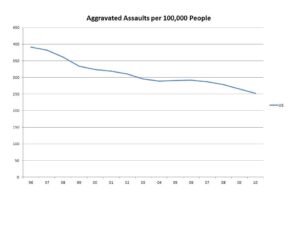
The murder rate in North Carolina is falling. The same is true nationally. A recent article suggests that shootings are actually up, but deaths are down due to medical advances. At least the first part of that claim is almost certainly wrong.
The chart below illustrates the decline in murders.
The article in question is this one, from the Wall Street Journal. It is entitled In Medical Triumph, Homicides Fall Despite Soaring Gun Violence. It argues that the fall in homicides cannot be due to falling overall crime rates because “[t]he reported number of people treated for gunshot attacks from 2001 to 2011 has grown by nearly half.”
Instead, the article concludes, the decline is due to improved medical care for gunshot victims, including “the spread of hospital trauma centers—which specialize in treating severe injuries—the increased use of helicopters to ferry patients, better training of first-responders and lessons gleaned from the battlefields of Iraq and Afghanistan.”
I seriously doubt the suggestion that there’s been a 50% increase in shootings since 2001. Aggravated assaults are way down, according to FBI data. The FBI’s Uniform Crime Reporting system defines an aggravated assault as an assault “for the purpose of inflicting severe or aggravated bodily injury . . . usually accompanied by the use of a weapon or by other means likely to produce death or great bodily harm.” Here’s what FBI data show about aggravated assaults.
The decline in aggravated assaults pretty closely tracks the decline in murders. It suggests that the reduction in violent conflicts explains the fall in homicides, and casts severe doubt on the idea that more people are getting shot.
Of course, it is theoretically possible that while there are fewer aggravated assaults overall, more of them involve gunplay. But the data that claim to show a rise in shootings don’t look very solid. The data come from the National Electronic Injury Surveillance System, run by the U.S. Consumer Product Safety Commission. That data is based on a “probability sample of hospitals in the U.S.,” so it is not comprehensive. And, the data are really intended to measure “injur[ies] associated with consumer products,” not criminal activity. This adds to my skepticism that shootings are up by 50%, or that medical care has advanced so rapidly that it can more than offset a 50% rise in shootings.
None of this is to say that medical care is not improving or that it has not contributed at all to falling murder rates. In fact, the most intriguing data cited by the article suggest a modest effect. The article cites data to the effect that “[i]n 2010, 13.96% of U.S. shooting victims died, almost two percentage points lower than in 2007.” Based on my back of the envelope calculations, a fall in fatality rate from 16% to 14% would almost exactly explain the observed decline in murders from 2007 to 2010 assuming a constant number of shootings. (It would be nowhere near enough to offset the supposed 50% increase in shootings.) For the reasons given above, I doubt that the number of shootings has been constant, so I suspect that even this modest effect is probably overstated.
Medical progress, probably. Medical triumph, I doubt.


